I’ll be honest and admit right away that when AI tools like DALL-E and GPTs started popping up, I was hyped. Then, in late 2022, when ChatGPT blew up, and suddenly everyone was talking to AI, I knew generative AI was going mainstream, and I had to check them out.
Since then, I’ve tested AI chatbots, content generators, image creators, AI video generators, and other generative AI tools. Some were great. Others? Let’s just say I spent more time setting them up than creating (looking at you, early AI image generators).
But through all the hype and half-baked tools, I’ve kept my focus on the best generative AI tools, the ones that actually help professionals, writers, coders, marketers, and creators, work smarter, not harder.
From OpenAI’s ChatGPT to Google’s Gemini, from MidJourney’s mind-blowing images to Synthesia’s AI video magic, I’ve seen how far these tools have come.
Now, after sorting through the good, the bad, and the just plain unnecessary, I’ve put together a list of the best generative AI tools that actually deserve a spot in your workflow.
9 best generative AI tools for 2025: My top picks
- ChatGPT for the best AI chatbot for conversations and productivity. ($20/month)
- Gemini for the best LLM advanced reasoning and content generation and the best ChatGPT alternative. ($19.99/month)
- GitHub Copilot for the best AI tool for code autocompletion and developer productivity. ($10/month)
- Grammarly for AI-powered writing and grammar correction tool.($12/month)
- AKOOL for AI image and video generation with face swapping feature. ($39/month)
- Synthesia for AI-generated video creation with lifelike avatars. ($18/month)
- Murf.ai for high-quality AI voice generator for professional use. ($19/month)
- Canva for AI-powered content design and marketing tool. ($12/month)
- GPTZero for the Best AI tool for detecting AI-generated content. ($8.33/month)
*These are the top-rated software in their respective category of generative AI tools on G2, ranging from AI chatbots and large language models to AI content creation platforms and AI content detectors. Most of these tools provide a free plan or trial. I have included the starting price of their paid plans for easy comparison.
9 best generative AI tools I’ve tried and loved
For me, generative AI tools aren’t just software. They’re creative partners, problem-solvers, and (on really busy days) lifesavers. They help me brainstorm faster, automate the tedious stuff, and unlock ideas I wouldn’t have thought of on my own.
At their core, these tools generate something new—text, images, code, videos, and even voices, based on what they’ve learned from massive datasets. But the best ones? They don’t just spit out generic results. They enhance how we think, create, and work. They give us a starting point, a creative boost, and sometimes, a much-needed reality check when we realize that AI still isn’t perfect.
I’ve had moments where AI completely transformed how I approach work and others where I’ve sat there, staring at a screen, wondering why it gave me the most ridiculous output (seriously, why does AI struggle with hands?). But that’s part of the journey: finding the tools that actually make life easier, not harder.
How did I find and evaluate the best generative AI tools?
There are new AI tools released every day. To cut through the noise, I started with G2 data, using their grid reports across nine categories, namely, AI chatbots, coding tools, image and video generators, writing assistants, content platforms, content detectors, large language models, and more. I narrowed it down to the top five tools in each category.
Beyond G2, I scoured online communities to spot trending AI tools that professionals were actually using, resulting in a shortlist of 50 AI tools.
Over the next few months, my colleagues and I tested these tools within our respective domains. While I focused on AI writing assistants, chatbots, image generators, and content platforms, my colleagues, who have written extensively on AI coding tools, LLMs, content detectors, and text-to-speech apps, brought in their expertise to evaluate those categories.
To get a broader perspective, we also used AI to analyze and summarize thousands of user reviews (well, didn’t I say I use AI extensively in my workflow?) to understand what other users like and dislike about these tools and compare their experiences with ours.
By combining hands-on testing, real user insights, and AI-driven analysis, we identified the most reliable and high-performing generative AI tools. From writing and coding to design and content generation, these tools didn’t just look impressive in demos. They consistently delivered in real workflows.
What makes the best generative AI tool: My checklist
With so many generative AI tools on the market, choosing the best isn’t just about picking the most popular names. My colleagues and I followed a structured evaluation process to test and compare each tool, ensuring we prioritized performance, usability, and real-world value over hype. Here’s the detailed checklist we used to separate the best from the rest.
- Accuracy and output quality: Generative AI is only as good as the content it produces. We assessed each tool’s ability to generate accurate, high-quality results across different applications.
For AI writing tools, we tested for coherence, factual accuracy, grammar, and contextual understanding, ensuring minimal hallucinations. AI coding tools were evaluated based on syntax correctness, efficiency, and debugging capabilities across various programming languages. AI image generators were judged on realism, detail, resolution, and adherence to prompts, while AI video generators were analyzed for frame consistency, lip-sync accuracy (for avatars), and animation smoothness. For text-to-speech tools, we focused on natural tone, pronunciation, emotional variation, and response time. A tool that consistently produced high-quality, usable results with minimal intervention ranked higher.
- Usability and learning curve: A powerful AI tool is useless if it’s a pain to use. We paid close attention to how intuitive the interface felt: was the dashboard clean and easy to navigate, or did I have to dig through endless menus just to get started? The best generative AI tools worked right out of the box, while the ones that required excessive setup or technical know-how quickly dropped down our list.
- Speed and performance: AI should enhance productivity, not slow it down. We measured response time, processing efficiency, and overall system performance to see how quickly AI-generated text, images, code, or videos were produced. We prioritized tools that offered quick, seamless results without lag or crashes, especially for large-scale tasks like long-form content generation.
- Reliability and consistency: Some generative AI tools perform well one day and fail the next. To ensure stability, we tested them across multiple sessions over weeks to check for degradation in quality. Variability in outputs was another key factor: did the AI remain consistent, or did results fluctuate unpredictably? Additionally, we analyzed how well the tools handled complex prompts and nuanced requests without producing misleading or irrelevant results. Generative AI tools that delivered stable, repeatable performance were rated higher than those with unpredictable behavior.
- Customization and control: We looked at how much control users had over AI-generated content by assessing prompt tuning, adjustable styles, and revision capabilities. Tools that allowed detailed, fine-tuned prompts, let users define brand voice, artistic style, or coding conventions, and offered an interactive feedback loop for refining results ranked higher. Those that produced rigid, one-size-fits-all outputs scored lower.
- Data privacy and security: Generative AI tools process vast amounts of user data, making security and privacy considerations critical. We examined data handling policies, checking whether tools stored, shared, or used user data for further model training. Privacy-focused features such as local processing, opt-out options, and transparent data policies scored higher.
- Pricing and value for money: Not every AI tool justifies its price tag. We analyzed free vs. paid features, subscription costs, and overall return on investment. Some tools offered robust free plans, while others had essential features locked behind high-priced tiers. We prioritized tools that struck the right balance between affordability and functionality, ensuring that paid plans actually provided significant value.
After evaluating 50 AI tools across different categories, I narrowed it down to the 9 best generative AI tools. They’re reliable and friendly and make our workflow more productive and efficient. The list below contains genuine user reviews from the respective product pages on G2.
*This data was pulled from G2 in 2025. Some reviews may have been edited for clarity.
1. ChatGPT
Category: AI chatbot software, AI code generation software
ChatGPT is probably the most well-known generative AI tool out there. I’ve used it for just everything from drafting blog posts and brainstorming marketing ideas to answering random late-night questions like “Why do cats knock things off tables?” (spoiler: they’re just tiny chaos agents). But like any tool, it’s got its strengths and a few quirks.
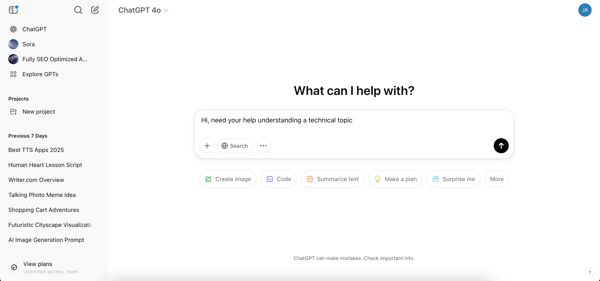
Accessing ChatGPT is super-easy now, with no login requirement. It’s as simple as opening a site and starting to ask questions. But for features like voice mode or image generation, we need to sign up for either a free plan or a paid one.
Let me be frank here: I’m a ChatGPT Plus user. The upgrade makes a difference to me as I use it extensively for writing, coding, brainstorming, and research. The access to advanced models, like GPT-4o, GPT-4, and GPT-o, that are noticeably sharper, and the added perks (like access to new features) make it worth it. That said, the free version is still solid for everyday tasks.
Should you upgrade to ChatGPT Plus? I break it down in my full review: Is ChatGPT Plus worth it? Check it out to see if the extra features justify the price!
ChatGPT is fast, efficient, and surprisingly good at structuring ideas when my brain refuses to cooperate. One of its biggest strengths is how versatile it is. I can ask for a witty tweet one minute and try writing a code in the next minute, and it handles both with ease. It also keeps track of context within a conversation, so I don’t have to repeat myself constantly.
My favorite feature is ChatGPT’s memory controls. I can explicitly tell it to remember things, ask what it remembers, and even reset or update its memory, either through conversation or settings.
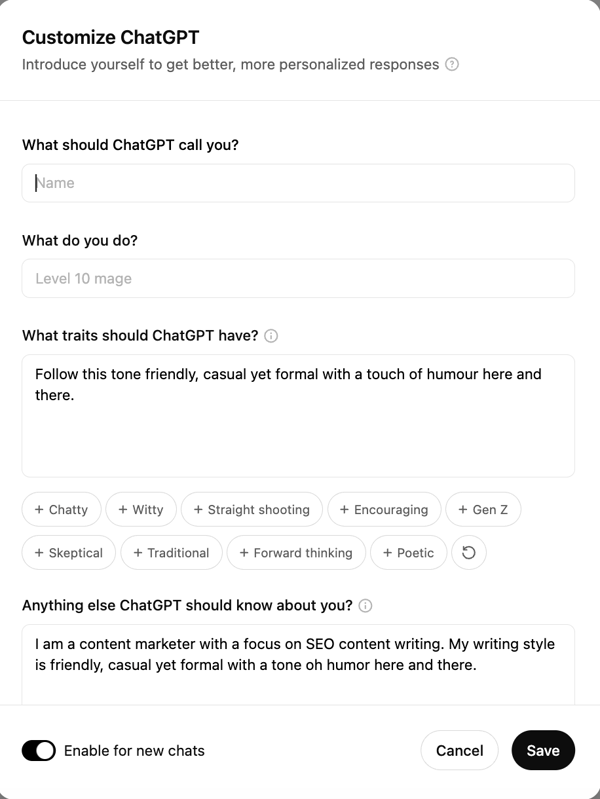
But the feature that excites me the most is the ability to build custom GPTs. Instead of a one-size-fits-all chatbot, I can fine-tune ChatGPT to behave exactly how I want, whether for a specific writing style, a coding assistant, or even an AI persona for brainstorming.
I’ve relied on ChatGPT to write HTML and JavaScript for interactive tools and web pages—ones that are now live on our website. Note that I have no experience coding at all, but that hasn’t stopped me from using it to build things that actually work. ChatGPT helps me generate full scripts, optimize code, understand algorithms, and even help with debugging.
It’s also been incredibly useful in breaking down complex datasets, writing Excel formulas I wouldn’t have figured out on my own, and even generating Pandas scripts to automate repetitive tasks. I wouldn’t have thought of using these advanced methods if not for ChatGPT honestly. And did I mention that we can now browse with SearchGPT also? If I need real-time information, I just switch to browsing mode and get up-to-date search results.
ChatGPT can also double down as an AI image generator powered by the DALL E3 model, albeit with limits on the number of images you can generate in the free tier and with fewer controls for tweaking it. I’d say there are other free AI image generators that do an even better job with more controls.
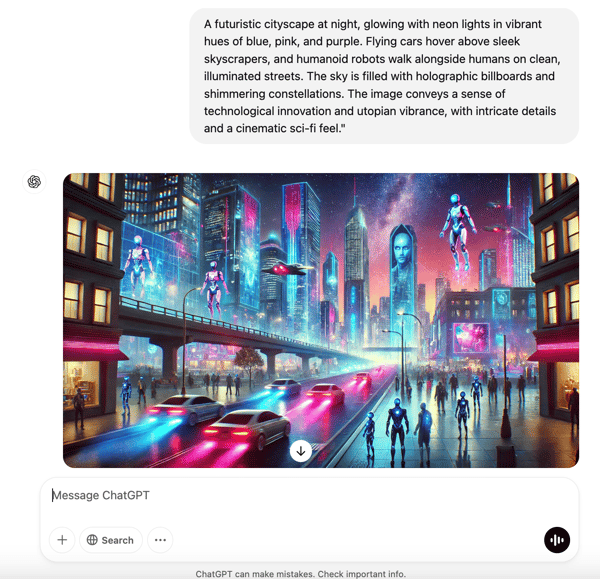
All good things aside, ChatGPT does have its quirks. It sometimes exudes an almost comical level of confidence, even when it’s completely off the mark. So I’ve learned that fact-checking is essential. While it’s fantastic for general knowledge, I’ve noticed it can struggle with niche, highly technical, or industry-specific topics, often offering generic answers that lack the depth I need.
Occasionally, I’ve also noticed that it repeats the same information instead of offering fresh insights. While the free version is great, the limitations on chats, file uploads, and data analysis can easily feel restrictive. Even as a Plus user, I have hit limits a lot of times, and it’s sometimes annoying to wait or downgrade to another model before the limits reset.
There are also times when ChatGPT simply doesn’t understand the prompt and gives irrelevant or generic responses, forcing me to tweak my input multiple times.
Regardless of these hiccups, ChatGPT remains one of the most powerful generative AI assistants available today. I highly recommend you try it if you haven’t yet.
What I like about ChatGPT:
- It’s my go-to for brainstorming and research. Whether I need content ideas, a quick summary of a complex topic, or help structuring an article, ChatGPT saves me so much time. It feels like having a personal assistant who’s always ready to help.
- It makes coding easier even for someone without a formal coding background. I’ve used it to generate HTML and JavaScript, troubleshoot errors, and understand concepts that would have taken me hours to figure out on my own.
What G2 users like about ChatGPT:
“I love this tool beyond anything! ChatGPT has made my life so simple, and I can literally ask anything that comes to my mind. It is like a friend, mentor, guide, or anything you like it to be. I can ask anything, and it gives me the answers, and after a little back-and-forth, it gives me the perfect answers every time!!”
– ChatGPT Review, Sakshi S.
What I dislike about ChatGPT:
- The usage limits can be frustrating. Even as a Plus user, I’ve hit message caps at the worst times, especially when I’m deep in research or debugging something. Having to wait or switch models disrupts my workflow.
- Sometimes, it just doesn’t get what I’m asking. There are times when I have to tweak my prompt multiple times because ChatGPT either misunderstands the request or gives a vague, generic response instead of something useful.
What G2 users dislike about ChatGPT:
“Sometimes, ChatGPT struggles with deeply nuanced or highly specialized queries. It might provide answers that are too general or miss subtle details, requiring additional clarification or manual fine-tuning.“
– ChatGPT Review, Shikar S.
Other Top AI Chatbots I’ve Tried: The Best ChatGPT Alternatives
- Gemini for Google-integrated AI assistance and research
- Simplified for AI-powered marketing content creation with chat like interface
- Zoom Workplace for AI-driven meeting summaries and collaboration
- Kore.AI for enterprise-grade AI chatbots and automation
- Tidio for AI-powered customer support and live chat
- Podium for AI-enhanced messaging and reputation management
- Claude for natural, context-aware conversations with a focus on safety and ethics.
For a detailed review of each product, you can read my article on the best AI chatbots.
2. Gemini
Category: Large language models, AI chatbot software
If there’s one chatbot I keep open all the time, along with ChatGPT, it’s Gemini. But if I call it just a chatbot, that doesn’t do it justice. It’s one of the top-rated large language models (LLMs) out there, optimized for everything from text generation to multimodal tasks like processing images, audio, and video.
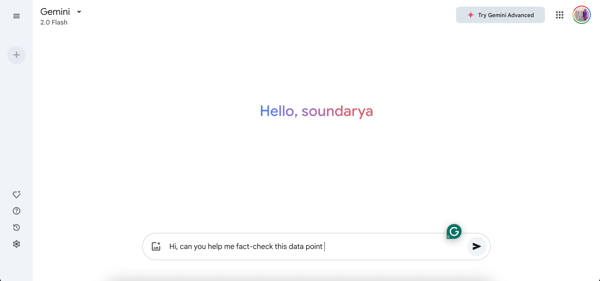
Gemini 2.0 Flash, the latest iteration, is designed for speed and versatility, while previous models like Gemini 1.5 Pro focused more on complex reasoning. From what I’ve seen, Google has clearly positioned Gemini as more than just a conversational AI. it’s a full-fledged LLM built to handle high-volume data processing, creative content generation, and advanced problem-solving.
It can analyze text, generate creative content, assist with coding, and even process images, making it more than just a chatbot.
With the release of Gemini 2.0 Flash, I feel it’s faster, smarter, and better at handling everyday tasks. If you’ve used Gemini 1.5 before, you’ll notice the step-up immediately. Responses feel more refined, the model understands context better, and overall, it’s just a smoother experience.
What sets Gemini apart from ChatGPT, in my experience, is its focus on natural, flowing conversation. While ChatGPT is excellent at generating text and following instructions, Gemini feels more like a true dialogue. It’s less about giving commands and more about having a back-and-forth. I find myself using them for different purposes – ChatGPT for structured tasks, and Gemini when I want to explore ideas and have a more dynamic interaction.
Beyond conversation, Gemini has features that have impressed me over time. It supported real-time web browsing long before ChatGPT got that capability, which was a huge plus. The fact-check with Google feature is another favorite. I can easily verify AI-generated responses with sources from the web, making it especially useful when researching or cross-checking information.
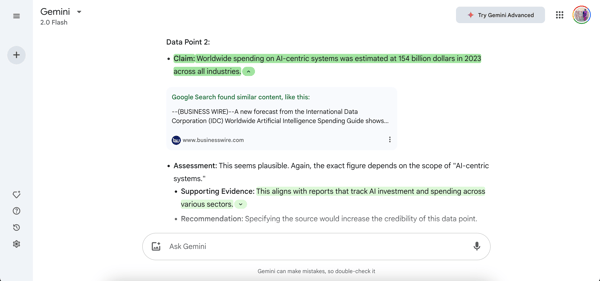
I also like its AI image generation capabilities powered by the Imagen 3 model. It’s not as sophisticated as other AI image generators but I definitely like to play a lot with it, creating a number of images given it has no limits on number of images generated.
There are a few downsides too. One of the biggest drawbacks is the lack of file uploads for data analysis or other tasks when using the free version via the website. I can only upload images when using Gemini on browser. If I need to upload files, I am limited to the mobile app, which isn’t always convenient.
Another thing to note is that Gemini’s deeper integrations, like in Gmail, Docs, and other Google services, are only available through the Google One AI Premium Plan or for those using Google Workspace business accounts.
But here’s the thing—despite those quirks, Gemini is still one of my go-to AI tools. It’s fast, smart, and feels like an actual assistant rather than just a chatbot. If you’re someone who needs AI to help with research, content creation, or just getting through your daily workload, it’s 100% worth keeping open alongside ChatGPT.
What I like about Gemini:
- Unlike some AI models that just follow commands, Gemini actually keeps up with the flow of a discussion. I can jump between topics, and it still understands the context, making interactions feel way more natural.
- I love that I can verify responses with Google’s fact-check feature. It’s super handy when I need up-to-date info or want to double-check something without leaving the chat
What G2 users like about Gemini:
“It is the best assistant to have as a writer and editor. It can be used to brainstorm ideas for any work and is very helpful with innovative insights. It is one of the best research assistants, and it doesn’t disappoint.”
– Gemini Review, Dr. Fizza Y.
What I dislike about Gemini:
- It’s frustrating that I can’t upload files for analysis unless I’m using the mobile app in the free version. On the web version, I can only add images, which feels limiting compared to other AI tools.
- It’s a little disappointing that features like Gmail & Docs integration are only available with the Google One AI Premium Plan. It would be great if at least some of these were accessible for free users.
What G2 users dislike about Gemini:
“Sometimes, Gemini will fail to provide accurate solutions and does not accept documents and doesn’t have the ability to read and understand documents”
– Gemini Review, Suma G.
Other LLMs you can consider trying:
- BERT for natural language understanding and text embeddings.
- Meta Llama 3 for open-source AI development and research.
- GPT-3 for general-purpose text generation and conversation.
- IBM Watsonx.ai for enterprise AI solutions and business automation.
- GPT-4 for advanced reasoning, coding, and human-like responses.
- Megatron-LM for high-performance AI training on large datasets.
- AutoGPTfor exploring autonomous AI agents and task automation.
Check out our in-depth article on the best LLMs. for a detailed breakdown of their features, strengths, and use cases.
3. GitHub Copilot
Category: AI code generation software
As I’ve mentioned before, I’m not a coder by trade. But ever since I started using generative AI tools, I’ve found myself diving into coding more than ever. And if there’s one tool that kept coming up in conversations with my developer friends, it was GitHub Copilot.
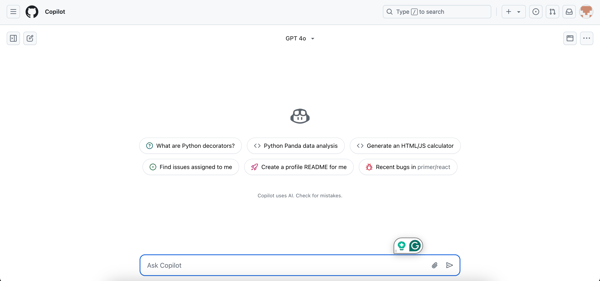
Right off the bat, I noticed that GitHub Copilot gives users the option to choose their preferred large language model (LLM) for generating code, including GPT-4o, Claude 3.5 Sonnet, and the o1 models from Azure OpenAI.
I gave the tool a try and immediately appreciated that I don’t have to start from scratch. I can describe what I need in plain English, and Copilot generates a working code snippet that I can tweak, much like ChatGPT. For someone like me, without a formal coding background, it’s been a huge confidence booster, helping me understand code structure, syntax, and logic without feeling overwhelmed.
For example, see how I used it to generate code for a home screen dashboard for my pet project. With a few tweaks here and there, I had a working dashboard.
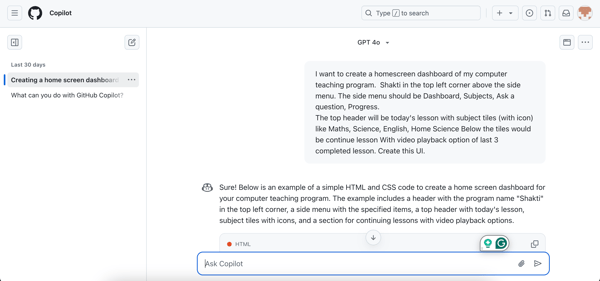
That being said, my experience with GitHub Copilot is still at a beginner level, so I relied on insights from my colleague, who uses it extensively for development work.
From what I’ve seen and from their feedback, Copilot is a massive time-saver for developers, whether they’re writing new code, debugging, or automating repetitive tasks. Instead of spending hours searching through documentation, Copilot provides smart code suggestions that speed up the process and make development smoother.
Most of the time, it suggests code that they would write out anyway, and if the suggestion is wrong, they just start typing what they want, and it usually figures it out pretty quickly.

The best part, according to them? It integrates directly into their IDE (Visual Studio Code, IntelliJ), making it incredibly seamless to use. Copilot works right inside the editor, generating real-time suggestions as they type.
Of course, it’s not without its flaws. From what my colleague has shared, Copilot sometimes hallucinates functions that don’t actually exist, which can lead to unnecessary debugging. While it’s great at completing code within a single file, it struggles to analyze an entire project’s dependencies, meaning it doesn’t always “remember” everything in the broader codebase.
Irrespective of the drawbacks, GitHub Copilot is one of the best AI code generators out there.
What I like about GitHub Copilot:
- It makes coding so much more approachable. As someone without a formal coding background, I love that I can describe what I need in plain English, and Copilot generates a working code snippet that I can tweak. It’s like having a coding mentor guiding me through the process.
- My developer colleagues like that it works directly inside the IDE. It gives them real-time suggestions as they type, which makes coding feel more seamless and intuitive.
What G2 users like about GitHub Copilot:
“It excels in providing code snippets, which save a lot of time when automation repetitive tests or when dealing with complex logic. It gave us a huge advantage during migration from Cypress to the Playwright framework. (I like that I can) chat with Copilot inside VS code studio.”
– GitHub Copilot Review, Rostyslav B.
What I dislike about GitHub Copilot:
- Github Copilot can sometimes hallucinate code that doesn’t exist. My colleague has pointed out that Copilot occasionally suggests functions that aren’t real, leading to unnecessary debugging.
- Based on what I heard, Copilot doesn’t always grasp the full context of a codebase, meaning it can miss dependencies or suggest solutions that don’t fit the broader project.
What G2 users dislike about GitHub Copilot:
“The model is not trained enough to comprehend a somewhat difficult question. Sometimes it ignored the prompt that’s given, It sort of hallucinates. For example, it calls for a function of a module that doesn’t exist.”
– GitHub Copilot Review, Rheyhan F.
Other best AI code generators to try based on my research:
- Duet AI for coding support in Google Cloud & Workspace.
- Pieces for Developers for AI-powered code snippets and context-aware coding recommendations.
- Sourcegraph Cody for open-source AI coding assistant with AI-driven code search and project-wide understanding.
- Amazon CodeWhisperer for real-time code suggestions optimized for AWS development.
- Crowdbotics Platform for AI-assisted app development with pre-built components.
- Pareto for accessing multiple AI models through a single platform for AI coding and content generation.
- Salesforce Platform for low-code and no-code features and Einstein for developers to automate CRM functions.
4. Grammarly
Category: AI writing assistants
If there’s one tool I’d recommend to anyone with eyes closed, that would be Grammarly. It has been my go-to AI writing assistant for years and honestly, I can’t imagine working without it.
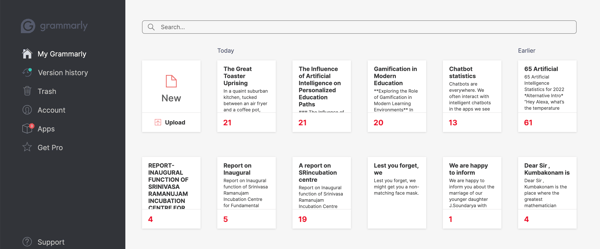
Whether I’m writing blog posts, drafting emails, or editing content, Grammarly ensures that my writing is polished, professional, and free of grammar mistakes, typos, and awkward phrasing.
If you move from the free to the paid plan, you’ll understand the real difference. With the Premium version, Grammarly does more than just fix grammar. It improves clarity, refines tone, and even suggests better sentence structures. I’ve also noticed that, over time, Grammarly has actually made me a better writer.
Grammarly now has an AI writer that can generate content from scratch, whether it’s blog ideas, project reports, emails, reports, or creative pieces. The free version comes with 100 AI-generated prompts, while the Premium plan offers 1,000, which is more than enough for anyone who isn’t creating AI-written content at scale.
You can see how I started writing one of my stories on Grammarly with its Write with Generative AI feature here.
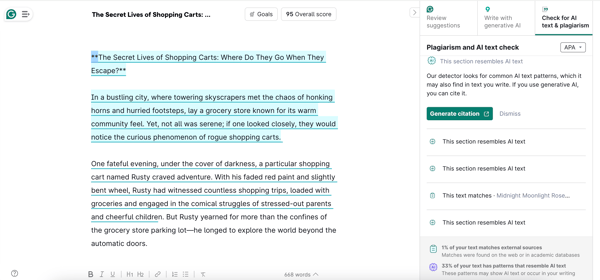
I really like how I can further improve the AI-generated text by easily selecting one of the available prompts to make it more persuasive or descriptive. The best part? I can use it directly inside Google Docs, emails, and other apps to refine what I am writing with the AI suggestions. The browser extension works flawlessly. See, for instance, how I can edit directly on Google Docs here and ask the AI assistant to rewrite a text.
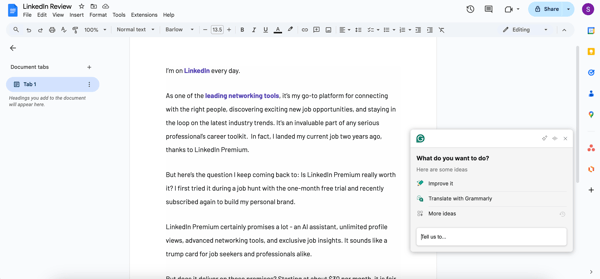
Another feature I found interesting is Grammarly’s AI content detector. It scans your text and flags sections that “resemble AI-generated text,” which could be helpful if you’re trying to balance human vs. AI-written content. However, from my testing, it seems to err on the cautious side, sometimes flagging perfectly human-written text as AI and, at times, marking completely AI-generated text as partly human text.
Still, it’s a useful tool for anyone in academia or professional writing who wants to double-check AI involvement in their content.
As useful as it is, it does have a few hiccups. One of the most common complaints that I’ve run into myself is that Grammarly sometimes misinterprets the context of a sentence and makes irrelevant suggestions. There have been moments when I was confident in my phrasing, but Grammarly insisted on a correction that didn’t actually improve the clarity or meaning.
This is especially true when I’m writing in a conversational tone. Grammarly tends to be overly aggressive with corrections, flagging sentences and phrases that are intentionally casual but correct. Sometimes, I find myself second-guessing my writing just because Grammarly keeps pushing a minor tweaks.
Another minor gripe is the hovering “G” icon. Sometimes, it it gets in the way when I’m typing in certain text on different apps or websites. While it’s useful for quick access, there are moments when I just want it to disappear so I can focus on writing. I know there’s an option to disable the browser extension for a website or an app. But still, an easier way to toggle it on and off when we click on the icon would make the experience smoother.
Nonetheless, I found Grammarly to be incredibly useful. Whether you’re a content writer, student, professional, or just someone who wants to polish your writing, Grammarly is a must-have AI writing assistant in your toolkit.
What I like about Grammarly:
- It’s more than just a grammar checker. I love that Grammarly doesn’t just fix typos. It helps me refine clarity, improve tone, and restructure sentences when needed. It feels like having a personal editor who makes my writing stronger.
- It integrates smoothly into my workflow. Whether I’m writing in Google Docs, emails, or even Slack, Grammarly works in the background, catching mistakes and suggesting improvements without disrupting my process.
What G2 users like about Grammarly:
“I recently started using Grammarly, and I can’t express enough how much it has improved my writing. It really helps with my writing by providing real-time feedback on grammar, punctuation, and style. The suggestions are clear and easy to understand, which helps me learn as I go along.
I especially appreciate the tone detector, which ensures my writing conveys the right message to my audience. Whether I’m drafting an email, writing a report, or working on an assignment, Grammarly has become an invaluable tool in my writing process. I highly recommend it to anyone looking to enhance their writing skills!“
– Grammarly Review, Jonathan L.
What I dislike about Grammarly:
- It sometimes misinterprets context. There are moments when Grammarly insists on a correction that doesn’t actually improve my writing, especially when I’m using a conversational tone. Instead of enhancing my style, it can make things sound too rigid or formal.
- The hovering “G” icon can be annoying. As helpful as Grammarly is, the little floating icon sometimes gets in the way when I’m typing. I’ve accidentally clicked it mid-sentence more times than I’d like to admit.
What G2 users dislike about Grammarly:
“There are certain times that the suggestions, particularly regarding tone, miss the mark or change the interpretation of the message. I also wish there was a way to dismiss a suggestion and have it remove the highlight or the notation that there is a suggestion since it can be distracting.”
– Grammarly Review, Riley B.
Other best AI writing assistants I recommend trying:
- Notion for AI-assisted note-taking and content organization.
- Apollo.io for AI-powered sales email and outreach optimization.
- Writesonic for generating high-quality marketing and ad copy.
- Jasper for AI-driven brand voice and long-form content creation.
- Constant Contact for AI-powered email marketing and campaign management.
- Anyword for AI-generated, data-driven copywriting with performance insights.
- TextCortex for AI-enhanced writing and rewriting across multiple platforms.
For full review, read our article on the best AI writing generators.
5. AKOOL
Category: AI image generators
My first encounter with AKOOL was through a mind-blowing ad campaign last year where you could swap your face into a video and “star” in a scene alongside a celebrity—all with just a selfie. It felt like something straight out of a sci-fi movie. Naturally, I had to dig deeper. That’s when I found out that AKOOL was the AI powerhouse behind it, and since then, I’ve been exploring the platform to see what else it can do.
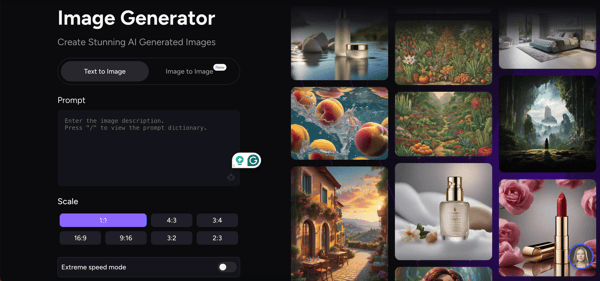
I’ve tested its AI image generator, face-swapping, video translation, and AI avatar features, and I can see why businesses, educators, and marketers are using it. It saves an incredible amount of time while keeping video production quality high.
AKOOL’s image-generating capabilities are on par with other AI image generators, and I am an absolute fan of its face-swapping feature. What I love the most is the ability to create custom avatars. Though it takes some time, I can create my own avatar by uploading a profile photo.
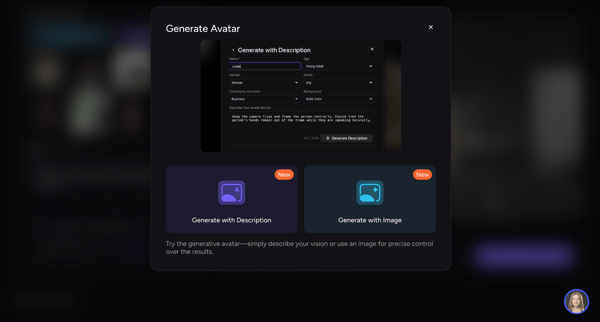
Aside from marketing use cases like the one I mentioned earlier, AKOOL’s AI avatar and video translation and editing features make it ideal for video presentations.
Say, for example, I need to create a training video for my colleagues who are all distributed globally and speak different languages. Instead of going the traditional video production route, I can create a custom AI avatar, upload our script, and have the tool produce a complete video presentation. I can then translate it to other languages too and share it with everyone.
It’s a practical solution for global teams, customer training, or even onboarding videos, making content more accessible and scalable without the usual video production costs.
There are also a bunch of other cool functions, like talking photos. I personally use the talking photos feature to create some fun memes, like this Monalisa one.
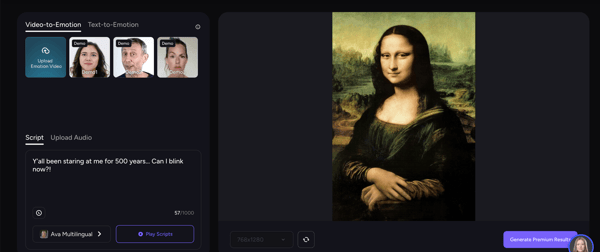
Even with its strengths, it has some rough edges. Creating a custom avatar takes some trial and error. While the AI avatars look impressive, getting one that actually resembles me wasn’t as straightforward as I expected. Adjusting facial features and fine-tuning details took some extra effort, and I can see how it might feel a bit cumbersome for someone who just wants a quick, ready-to-go avatar.
Also, the processing times can be a little slow, especially for high-resolution or 360-degree content, and it sometimes takes multiple attempts to get the right output. I get that quality rendering takes time, but a speed boost would make it even more efficient, particularly when handling multiple projects or working within a team.
Notwithstanding these cons, AKOOL is easily one of the most advanced AI image and video generators I’ve tried, especially when it comes to face-swapping, AI avatars, and multilingual video creation. The only catch? The free plan gives you just 100 credits, so you’ll burn through them pretty fast if you’re testing out different features.
That said, if you’re looking for a way to create high-quality AI-generated videos without spending hours editing, it’s definitely worth checking out.
What I like about AKOOL:
- The AI avatars and face-swapping are surprisingly realistic. It’s great for creating professional-looking content without recording anything myself.
- It gives me high-quality results with minimal effort. AKOOL’s image generation works well right out of the box. I can swap faces, enhance images, and create visuals without spending hours fine-tuning details.
What G2 users like about AKOOL:
“The AI Image generation feature in AKOOL is just awesome. It’s surprisingly simple to create decent looking pictures from basic text inputs. This has saved us tons of time on design projects. Sharing projects and working on them at the same time has increased our efficiency tremendously.”
– AKOOL Review, Nadine P.
What I dislike about AKOOL:
- Creating a custom avatar takes some trial and error. While the avatars look good, getting one that actually resembles me wasn’t as easy as I expected.
- Processing times can be slow, especially for high-resolution videos. I get that AI rendering takes time, but sometimes I have to wait longer than expected, especially when working with 360-degree content or handling multiple projects at once.
What G2 users dislike about AKOOL:
“I have seen a few glitches with rendering videos from time to time, and this can be a bummer if you are working on a deadline. A stable performance would be great.”
– AKOOL Review, Allan B.
Other best AI image generators I’ve tried and loved:
Read my complete review with examples of AI-generated images in this article on the best free AI image generators.
6. Synthesia
Category: AI video generators, Text-to-speech (TTS) software
I first came across Synthesia when I was looking for a way to create AI-powered training videos without having to record myself on camera. I wanted something fast, professional, and easy to use, and after testing it for a while, I can confidently say that Synthesia is one of the best AI video generators out there.
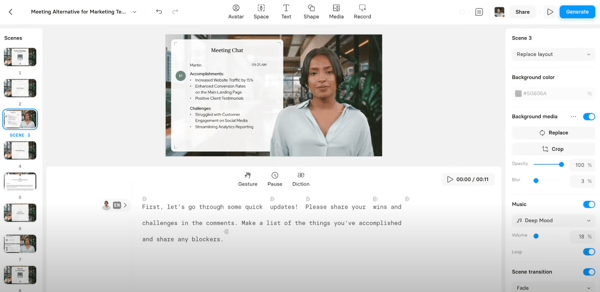
Now I’ll say this upfront: Unlike AI video tools like Runway or OpenAI’s Sora, which focus more on cinematic, AI-generated scenes, Synthesia is built for business. It’s great for corporate training, explainer content, and marketing videos, making it a great choice for anyone who wants high-quality videos without the hassle of filming, editing, or hiring a production team. So, if you are looking for generative cinematic or imaginary scenes, check out the other recommendation list in the callout below.
Using Synthesia is simple. I can pick from a bunch of realistic AI avatars or even create my own, choose a video template, drop in my script, edit transitions and graphics, add AI voiceovers, and boom—my video is ready. It’s all done without needing a camera, microphone, or editing software.
One of the best parts? The templates and AI voiceovers. Instead of spending hours editing the video, adding text, recording, and syncing audio, the AI handles everything for me. What I love most about AI in this format is how repeatable and consistent it is. Once I figured out the process, I could crank out videos in no time.
Plus, it supports multiple languages, so I can easily create videos for different audiences without re-recording, hiring a voice artist, or manually adding subtitles. However, the one-click translation of videos to other languages is available only in the Enterprise plan, along with other features like importing PowerPoint or adding our own voiceovers.
That brings me to a few areas where Synthesia could improve. While the AI voice synthesis is pretty solid, I’ve had moments where it still sounded a little robotic or flat, especially in longer scripts. A bit more natural variation in tone and inflection would make a huge difference. I’ve also noticed that pronunciations aren’t always perfect, which means I sometimes have to tweak the phrasing or spell words phonetically to get the right delivery.
Another minor gripe is the lip sync. Most of the time, it looks smooth, but every now and then, it feels slightly off, especially with more complex sentences. It’s not a major issue but a little more refinement in facial movements would make the avatars even more realistic.
But these issues aside, Synthesia is one of the best AI video tools I’ve used for business content. It’s not without drawbacks, but if you need high-quality videos without filming, it’s worth trying.
Currently, free users can create 3 minutes of AI-generated video using Synthesia.
What I like about Synthesia:
- Creating videos is ridiculously easy. I just type my script, pick a template, and let Synthesia do the rest. It’s the best when I need a polished video fast.
- With support for multiple languages, I can create multilingual videos without extra work.
What G2 users like about Synthesia:
“Absolutely love the choice of avatars and voices within Synthesia. A big plus was their ethics as well – you cannot upload images or videos of other people here – this is very important to me. It is also super easy to use – I have been using it to add depth to my elearning process videos for software training – it makes it so much more professional and engaging – at least I hope it does!”
– Synthesia Review, Julie F.
What I dislike about Synthesia:
- I sometimes feel that the AI avatars and voices come across little too mechanical. While they’re impressive, there are moments where the expressions and speech delivery feel a bit stiff, making the avatars seem less natural than a real presenter.
- Lip sync isn’t always perfect. Most of the time, the avatars look great, but every now and then, the mouth movements don’t quite match the speech, making it feel a little off.
What G2 users dislike about Synthesia:
“There are areas that need improvement. When incorporating screen recordings, I sometimes encountered synchronization delays or issues when adding videos to a “slide,” which required multiple retakes to align everything correctly. Another drawback is that the video preview often doesn’t match the final export. This inconsistency forced me to generate mid-version exports just to verify the output, leading to an early depletion of my generation minutes.
Speaking of generation minutes, their limitation is arguably Synthesia’s biggest drawback. Either the previews need to work seamlessly as accurate representations of the final export, or the allocation of generation minutes should be more generous to account for these discrepancies.”
– Synthesia Review, Riccardo Z.
Other best AI video generators and Synthesia alternatives I like:
- VEED for quick and easy AI-powered video editing.
- Canva for a beginner-friendly AI video generator to create realistic and imaginative scenes from text.
- OpusClip for AI-driven short-form video repurposing.
- Colossyan Creator for AI-generated training and corporate videos.
- Wondershare Vibro for AI-powered video enhancement and effects.
- Rask AI or AI video translation and dubbing.
- AI Studios for realistic AI avatars and presentations.
7. Murf.ai
Category: Text-to-speech (TTS) software
Murf.ai has quickly become one of my favorite AI text-to-speech tools, and for good reason. One of my mom’s pet projects is creating video lessons for students by using the lesson script. I’ve tested a bunch of text-to-speech apps to help her do this quickly at scale, but Murf.ai really stood out for its realistic, natural-sounding voices.
A lot of AI-generated voices still sound robotic or emotionless, but I felt Murf’s second-generation of voices actually capture tone and emphasis, making the narration feel far more human-like. I could filter voice by age, gender, and voice styles and select what type of project it is, say, promo, narration or newscast or even select emotions like sad, cheerful, and more.
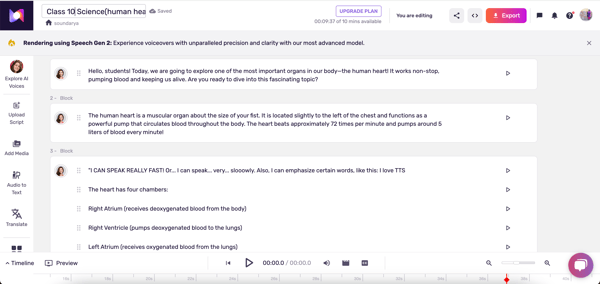
Beyond just sounding good, Murf gives me full control over the voice output. I can adjust pitch, speed, pauses, and emphasis to fine-tune the delivery. It makes it perfect for tutorials, e-learning, storytelling, podcasts and even marketing content. The ability to choose from multiple languages and accents is another major plus, making it a great option for global content.

Another small but useful feature is the ability to break down text into sentences for easy editing. Instead of redoing an entire section, I can just tweak individual lines and reprocess them—a huge time-saver.
Something that I absolutely love is the pronunciation feature where I can specify how I want specific words to be pronounced in the audio, I could even create my own library of words with specific pronunciations.
But that said, it’s not all smooth sailing. Murf’s free plan gives plenty of room to test the tool, allowing me to create up to 10 minutes of audio from my script. It’s great for getting a feel for the voices and features, but there’s a catch. While I could preview everything, I couldn’t download them without upgrading to one of their paid plans.
I also found that some of the advanced features, like AI translations, custom voices, voice changeovers, and high-speed rendering of output, are locked in behind higher-tier plans, some of which I wanted to use. So, if you’re on a basic plan, you might find yourself wishing for more.
Also, while Murf has a great library of voices, especially for US and UK English, I felt that some regions don’t have enough local voice options, and there aren’t many child-specific voices either. I know it’s a work in progress, but it would be great to see more diversity in voice selections, especially for content that requires a more regionally authentic or kid-friendly tone.
Despite these drawbacks, Murf.ai is still one of the best AI voice generators available. It’s easy to use and produces high-quality, natural-sounding speech that makes content creation much easier.
What I like about Murf.ai:
- I really liked that the voices actually sound human. A lot of AI-generated voices still have that stiff, robotic feel, but Murf’s second-gen voices capture tone, emphasis, and even emotion, making them way more natural.
- Tons of control over voice customization. I can tweak the pitch, speed, pauses, and even emphasis to make the narration sound exactly how I want. It’s perfect for e-learning, explainer videos, or marketing content.
What G2 users like about Murf.ai:
“I liked that their free trial gave me enough time/credits to evaluate the quality of the voices. The voice generation has done well for the project I am working on. I like that Murf.ai can break the text into sentences so that I can make corrections at that level. The ability to add pauses is nice, and they have a good selection of stock music to choose from.”
– Murf.ai Review, Steve O.
What I dislike about Murf.ai:
- The best features are locked behind higher-tier plans. While Murf’s free plan lets me test the tool, I can’t export audio without upgrading, and some of the more advanced features, like voice cloning and “Say It My Way”, are only available on higher-priced plans.
- Limited child and regional voice options. While there’s a great variety of voices, I’ve noticed fewer options for kid-friendly narrations or accents for certain regions, which would make it even more versatile.
What G2 users dislike about Murf.ai:
“It is a shame that the most powerful parts of the product incuding, say it as I would, and variations of expression are reserved for those who can pay high premium prizes. It would have been nice to be given some access to these features for those who create for a living but don’t have extensive finances.”
– Murf.ai Review, Verfied G2 user.
Other best text-to-speech apps I suggest checking out:
You can read the detailed review of each product in our article on the best free text-to-speech apps.
8. Canva
Category: AI content creation platforms
Canva has been my go-to for quick and easy designs for years now, but with the new AI-powered features like Magic Media and Dream Labs, it’s more powerful than ever. Whether I need to design social media posts, presentations, or even marketing videos, Canva makes it ridiculously simple—no need for a professional design background.
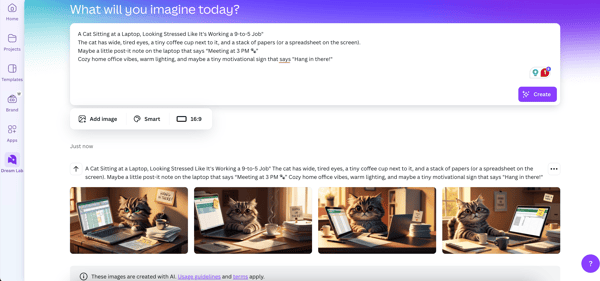
Magic Media is where things get interesting. It allows me to generate images, graphics, and even videos using AI, all without leaving the Canva editor. Instead of searching for stock photos or manually tweaking visuals, I can type in what I need, and Canva’s AI creates a custom image for me.
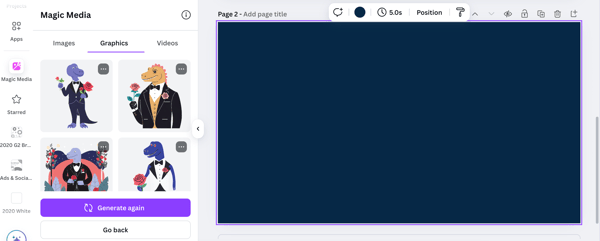
I absolutely love the suite of Magic editing tools, too, be it the background eraser, Magic Edit to change color or one particular aspect of the image, or Magic Grab to move an object in a photo. I dig them.
Then there’s Magic Write, Canva’s AI-powered writing tool. I use it for brainstorming text ideas, rewriting content, and adjusting tone as I design. As seen in the image above, it even lets me select how the AI rewrites text, whether I want something shorter, more formal, or even more fun (I may or may not have tested the “Sprinkle fairy dust” option just out of curiosity). It’s especially useful when I need to quickly tweak copy for a social post, blog snippet, or presentation slide.
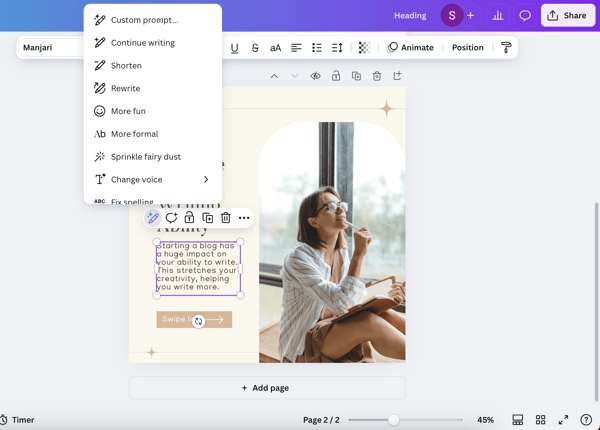
In my opinion, what makes Canva stand out is that it’s an all-in-one design platform that combines AI-powered tools, intuitive editing, and ready-made templates. Unlike most other AI tools that focus on just image generation, video creation, or text editing, Canva brings everything together. I do not have to use an AI writer, then an AI image generator or video generators and then take the design to Canva or other editing software to polish. I can do it all without leaving Canva, which is a huge time-saver.
Now, Canva isn’t perfect. The AI-generated images don’t always hit the mark for me, like many other AI image generators, especially when it comes to human stock photos, and I sometimes have to manually refine the design to get it right.

Another limitation is that many of Canva’s AI tools, like Magic Media and advanced AI-generated media come with some limits for free users. For instance, free users are limited to 50 credits for Magic Media’s text-to-image feature and 20 lifetime uses of Dream Lab.
Even with its limitations, Canva is hands-down one of the easiest generative AI tools for content creation,. If you need a tool for design, writing, and media generation, I’d recommend it in a heartbeat.
What I like about Canva:
- AI-powered design is ridiculously easy. Magic Media lets me generate images and videos without leaving Canva, and Magic Resize is a lifesaver when I need to quickly adapt designs for different platforms—no more manually adjusting dimensions for every post.
- Magic Edit and other features make quick image adjustments effortless. I can swap out objects, tweak colors, or remove elements without needing Photoshop-level skills. It’s super handy when I need to make small edits on the fly.
What G2 users like about Canva:
“I love Canva’s Magic Media tools. They make it so easy for me to create graphics for my company. Their ease of use is amazing.”
– Canva Review, Colin W.
What I dislike about Canva:
- The free plan is pretty limited. Some of the best AI tools, like Magic Media’s text-to-image generation and Dream Lab, are capped for free users, so I can’t experiment as much without upgrading to Pro.
- AI-generated images can be hit or miss. Sometimes, Magic Media nails it. Other times, the images look a little generic or off, and I still have to manually tweak them to get the right look.
What G2 users dislike about Canva:
“It is a great platform for beginners, but some of its AI features do not work perfectly. Also, its premuim cost is also very high.”
– Canva Review, Manoj J.
Other top AI content creation platforms worth checking out:
- Jasper for on-brand AI content.
- Scalenut for SEO-focused content and blog optimization
- Hypotenuse AI for AI-powered product descriptions and eCommerce copy at scale
- MarketBetter for conversational AI on website
- Copy.ai for quick AI-generated copy across multiple formats
- Writer for AI-powered writing and content generation with brand consistency.
- Amplience for intelligent content management, headless commerce, and dynamic media delivery.
9. GPTZero
Category: AI content detectors
Given that I’ve tested multiple AI writing tools, content generators, and chatbots, it only made sense to try AI content detectors too. Because let’s be real—nobody wants to read another article that starts with “In today’s rapidly evolving digital landscape…”
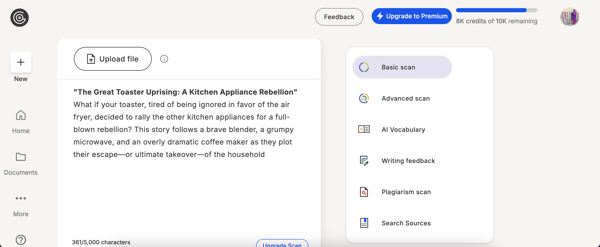
GPTZero was the first AI content detector I heard about, and it’s still one of the most widely used. It launched right when AI-generated content started raising concerns in education, publishing, and professional writing. While plenty of AI detectors have popped up since GPTZero remains one of the most trusted tools for identifying AI-written text.
I’ve used it extensively and have seen it used everywhere, from teachers checking student essays to businesses verifying content originality. What makes GPTZero stand out is its ease of use and accessibility. I could scan up to 10,000 words a month for free, and I actually did the first few checks without even signing up.
I found it particularly useful when running checks on long-form AI-generated content since it provides a clear breakdown of which parts were likely written by AI, edited by AI, or fully human-written. I like how it color codes what’s probably AI written, and what’s probably it thinks is written by a human.
Another feature that stood out to me was the writing feedback tool. It’s not as advanced as Grammarly or other dedicated writing assistants, but I liked that I could edit the text directly within GPTZero right after running a scan. It’s a small but useful touch, making it easy to refine content without switching between multiple tools.
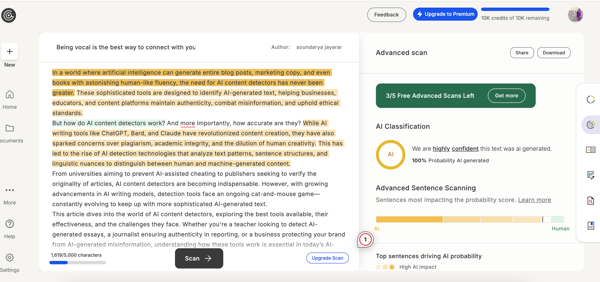
Now, if I am not directly using the app or website, I really like how I can integrate it into my workflow as well. I personally find the browser extension for Google Docs super convenient since it lets me check text without switching between tabs.
I can also embed it into existing systems via API, which is a huge plus for businesses and educational institutions that need AI content detection at scale. Educators will probably appreciate its integrations with LMS platforms like Moodle and Google Classroom, making it easier to scan student submissions without extra steps.
Even with its strengths, it’s not foolproof. One of the biggest concerns I have is that GPTZero can sometimes misclassify human-written content as AI-generated and vice versa. So, it’s best to use our judgment at times to take a call on content.
It also has limited ability to detect paraphrased or AI-altered text. If a piece of content was generated by AI and then lightly rewritten or reworded, GPTZero might not always flag it as AI-written, which makes it less effective for checking.
And also, the free plan limits can feel a little restrictive if you are a content writer like me and want to use the tool extensively. Even so, GPTZero is worth using if you need a straightforward way to check if a piece of writing is AI-generated.
Just keep in mind that no AI detection tool is 100% accurate, so it’s best to use it as part of a larger verification process.
What I like about GPTZero:
- It’s simple to use. I’ve tested multiple AI content detectors, and GPTZero consistently delivers clear, easy-to-understand results. It highlights which parts of a text might be AI-generated, so I’m not left guessing.
- Integrations make it super convenient. I like that I can use GPTZero directly in Google Docs with its browser extension or integrate it into LMS platforms like Moodle and Google Classroom—a huge plus for educators and content reviewers.
What G2 users like about GPTZero:
“The best part is the ability to detect AI-generated content with 95% accuracy. As a lead manager, my daily task is to check the content’s originality and integrity. I always need to check the content before submitting further. With this I can easily able to detect the content that it is written by a human or AI, this tool is a lifesaver for me.
I just need to provide the content. It analyzes the content and highlights whether it’s written by a human or AI in seconds. I can easily upload the file, and it will analyse it and give me a detailed report on which part is written by a human, AI, or AI-altered content.“
– GPTZero Review, Lacey D.
What I dislike about GPTZero:
- It struggles with paraphrased AI content. If a piece of text has been lightly rewritten or run through a paraphrasing tool, GPTZero might not flag it, which means it’s not always the best for catching AI-altered content.
- False positives can be annoying. Sometimes, human-written content gets flagged as AI-generated, which makes me second-guess the results. It’s a great tool, but I wouldn’t rely on it alone for critical content verification.
What G2 users dislike about GPTZero:
“GPTZero is not a 100% foolproof method for AI detection. It can sometimes provide the wrong conclusion or wrong percentage of AI-written text, though it is designed for search engine optimization and ensuring the authenticity of online and published content.
It is recommened to use it alongside other detection tools as it has limited detection for altered AI text. If a text is taken from AI and rephrased, it may not be identified by GPTZero.
– GPTZero Review, Sheetal J
Other AI checkers I have tried:
- Writer for enterprise-grade AI content detection and compliance.
- ZeroGPT for free AI text detection with basic analysis.
- Undetectable AI for free AI text detection with basic analysis.
- Originality.AI for AI and plagiarism detection in professional content.
- Copyleaks for academic and enterprise-level AI content verification.
- Corrector App for quick AI content detection and grammar correction.
- Content at Scale for detecting AI-generated long-form content
Read the detailed review of each tool in this article on best AI content detectors.
If you’re still exploring your options, I have a few more honorable mentions based on popular choices that are worth checking out.
While they didn’t make it to my main list, they’re fantastic in their own right.
- Claude is best for thoughtful, nuanced text generation and deep reasoning.
- Perplexity AI stands out for its AI-powered search with real-time web access, making it a solid choice for fact-checking and research.
- If you’re a developer, Replit offers AI-assisted coding with real-time collaboration, helping streamline the development process.

Frequently asked questions (FAQs) on generative AI tools
1. How do generative AI tools work?
These tools rely on large language models (LLMs) and multimodal AI trained on vast datasets. They predict and generate content by recognizing patterns in data. Some models, like GPT-4 and Claude, specialize in text, while others, like DALL·E and Midjourney, focus on image generation.
2. What are the best generative AI tools available today?
The best tool depends on your needs:
- ChatGPT and Gemini – Best for text generation and chat-based AI
- GitHub Copilot – Best tool for AI code generation
- Grammarly – Best AI writing assistant.
- Claude – Strong in nuanced reasoning and creative writing
- Canva, DALL·E, and Midjourney – Ideal for AI-generated images
- Stable Diffusion – Great for open-source image generation
- Synthesia, AKOOL – Best for AI video generation and AI avatars
- Murf.ai – Great text-to-speech application
- GPTZero – Best for AI content detection.
3. Are generative AI tools free to use?
Many generative AI tools offer free versions with limitations. For example, ChatGPT has a free plan, but GPT-4 is behind a paywall. Gemini allows free users to generate unlimited images, while others, like Midjourney, require subscriptions for full access.
4. Can generative AI replace human creativity?
Not entirely! AI is a powerful assistant, not a replacement for human creativity. While it can generate content, refine ideas, and automate tasks, it still relies on human input, guidance, and critical thinking to produce truly valuable work.
5. What are the risks of using generative AI?
Key risks include misinformation, plagiarism, bias, and data privacy concerns. AI models can sometimes generate inaccurate or misleading information, so fact-checking is crucial. Businesses should also be mindful of copyright issues when using AI-generated content.
6. Can generative AI be used for coding?
Yes! Tools like GitHub Copilot, ChatGPT, and Gemini are excellent for writing and debugging code. They help developers speed up tasks, generate scripts, and even suggest fixes for errors. However, AI-generated code should always be reviewed for security and accuracy.
The Future is AI-mazing
After trying these tools for so many days, one thing is obvious to me: there’s no single “best” AI—only the best one for what you need. The real advantage isn’t just in what these models generate, but how seamlessly they fit into our workflow, enhancing productivity, creativity, and even decision-making in ways that feel almost second nature.
For me, the best generative AI tool depends on what I need at the moment. If I’m writing a long-form article, I’ll lean on ChatGPT. If I want up-to-date, fact-checked information, Gemini is my go-to. And when I need creative brainstorming or image generation, there are plenty of specialized tools to choose from.
So here’s my takeaway: don’t settle for just one AI tool. Experiment, mix, and match. Use ChatGPT for writing, Gemini for real-time insights, Claude for complex reasoning, and AI art tools when creativity calls. The real power of generative AI isn’t just in what it can create. It’s in how we use it to enhance the way we work, think, and innovate.
Stay ahead of AI legal risks. Read this guide with tips from a legal expert on how to use generative AI tools safely in the workspace.



